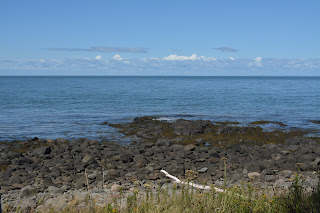Prince Edward Island
It's called PEI by everyone I've talked to –
Prince Edward Island is just too cumbersome to say, so from here on, PEI it
is! And what a place it is, too! I spent yesterday driving around the Eastern
part of the island, taking many small gravel roads that led to the beach
(although I didn't know that when I took the first two or three), meandering
along the roadway, sometimes stopping in the middle of the road to take photos
(nobody was coming either way!).
 |
| Flowers in the ditches. |
 |
| Birdhouse on a power pole! |
 |
| Birds on the beach. |
I am enchanted with this island. It is peaceful, quiet, unhurried, and just
really laid back, if I can use that phrase. As I was driving yesterday, I kept
thinking how tidy it all was. The fields are neat, the homes are well kept, and
the yards are mowed and nicely landscaped. The beaches are clean. The roads
were sometimes not so great, but not as bad as some other places I've been on
this trip (Newfoundland, I'm thinking of you!!). Even the roadsides are mowed!
 |
| Hay bales on a farm. |
The north shore, where I camped the first night
(in wind so fierce I couldn't cook because the stove wouldn't stay lit) is the
center for mussel farming, and I saw a number of those farms in St. Peter's
Bay. The lady at the visitor center was
very informative when I went in to ask what all those buoys were in the water.
The mussel farmers put very small mussels in what they call socks, which are
long pieces of netting, and they hang them from the buoys. The mussels grow
over the next 18-24 months, and when the farmer pulls up the sock, it is
encrusted with mussels ready to eat! I
haven't had any yet, but I'm not finished with PEI yet either…
Today was devoted to Green Gables, of Lucy Maud
Montgomery fame. The house about which
she wrote is now a national historic site, and the north shore where it lies is
a national park. Since the morning was sunny and warm, I decided to drive along
the shore road first (just in case it got nasty). It was breathtaking – the
cliffs are red sandstone, and there were lots of pull offs so that I didn't run
the risk of getting run over. This part
of the island had more people, tourists mainly, but still it was not very
crowded. I imagine that in the summer it
might be quite different.


After the shore drive, I went to the house, which
is open for tours and photographs are permitted. Yippee!
I wanted to share the house with two of my daughters-in-law, both who
love the Anne of Green Gables stories, so I can do that with pictures. It was
fun to see how the house was furnished (with period pieces) and to imagine how
it might have functioned back in the day.
The guidebook I'm using for this trip said that the whole thing was very
much a tourist trap, but I found it very interesting and not as touristy as I
expected. Yes there was a gift shop, but
it was away from the main part of the site, and it was easy to skip it if you
wanted to (I didn't skip it!).
 |
| Green Gables |
 |
| The dining room. |
 |
| Anne's bedroom |
Even some of the pathways that are described in
the books were now made into walking trails, and I did one of them.
 |
| Lover's Lane trail. |
The sun stayed out, and it made for a very
enjoyable day!










































